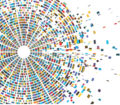There are more mobile devices than people on planet Earth right now.
It’s estimated that half of the world’s adult population has a mobile phone, and this number is expected to rise exponentially by 2020.
But despite this shift in technology becoming more democratic and accessible, 767 million people around the world remain in poverty, living on less than $2 a day.
Wireless giant Qualcomm sees the expansion of broadband service and proliferation of mobile phones as an opportunity, especially in developing nations. It believes mobile technology can be an essential tool in empowering women, providing education, and abolishing poverty. Through its social responsibility program, Wireless Reach, it partners with nonprofits, government agencies, and other tech companies to give people around the world access to new technology, the chance to connect, and a way to improve their socioeconomic situation.
“Wireless Reach came out of a team retreat we had ten years ago, because I was frustrated that Qualcomm had developed revolutionary new wireless technologies (then-3G systems) but wireless operators around the world had been relatively slow to deploy them,” says Bill Bold, Qualcomm’s senior vice president of government affairs. “We were targeting underserved markets where we could do a lot of good while simultaneously highlighting the value of new technologies. It was pretty basic at that stage, but in the last ten years my staff has really turned this into a world-class program.”

In Nairobi, Kenya, students like Alfred benefit from having technology in the classroom. Tablets with apps help address the shortage of teachers and textbooks in area primary schools, providing engaging curricula with songs, quizzes, and videos. | Photo courtesy Qualcomm Wireless Reach
Since its founding, the Wireless Reach team has worked in 46 countries on five continents. Several of its programs have enabled people to use cell phones in ways that weren’t possible before: communicating with health care providers, managing businesses so they can earn an income, and finding microfinance loans. Here’s a snapshot of some of these programs happening around the world.
Helping Expectant Mothers
Millions of women around the world are not able to see a doctor or other skilled health care worker when they’re pregnant, either because they live too far away from the nearest hospital or can’t afford it. In India, women in impoverished areas give birth in one-room clinics, and the country has a high infant mortality rate despite its emergence as an economic power: Every year, almost half of all worldwide newborn deaths (2.8 million) occur in India (700,000)*.
Infant mortality can be prevented with proper care and nutrition, and Wireless Reach has enabled midwives in Northern India to track an expectant mother’s vital signs and other health issues on a mobile phone. The company has a similar program near Morocco’s Atlas Mountains, where it developed remote ultrasound devices. Doctors use them to make house calls in rural villages and upload sonograms to a mobile phone. From there, the doctor can send the sonogram to a specialist at an urban hospital who can offer a second opinion.
A Chance at an Education
Across the Arabian Sea in Kenya, a nationwide effort to make primary school free for all children has been struggling since it was implemented in 2003. The school system wasn’t prepared to handle the surge in student enrollment, and teacher-to-student ratios of one to 56 and three children having to share a single textbook became the norm.
Wireless Reach partnered with a British solar company and two Kenyan tech firms to provide customized tablets to 430 students and 38 teachers at a primary school in Nairobi, powered with engaging lessons in math, English, and Swahili. The whole project is solar powered and off the grid, so it doesn’t tax the school’s power supply.

Winston Hawkins is a 71-year-old fisherman in La Boquilla, Colombia. Through Qualcomm’s “Fishing with Mobile Nets” program, he uses his tablet to get real-time oceanic conditions and navigation assistance, and can also track expenses along with his catch for the day. | Photo courtesy Qualcomm Wireless Reach
Plenty of Fish
In the seaside nation of Senegal, fish is a main of source of protein. Subsistence fishing is a way of life and source of income for many: About 90 percent of the fish in the entire country are caught by local fishermen and processed by women to sell at markets. It’s difficult for these fishermen to gauge when it’s safe to head out to sea, know how much their catch is worth, or to track fish stocks.
Wireless Reach, along with mobile phone carrier Tigo, provided fishermen in two coastal towns with phones that help monitor the weather, provide a GPS route to fish sources, and link up to an electronic marketplace that tracks daily prices. The program also developed health and safety videos for the fish processors to help them learn the best ways to clean and cut their catch. Wireless Reach launched a similar fisheries program in Colombia.
See It for Yourself
Wireless Reach and Temme Media recently teamed up to film a virtual reality video called Mothers of the Atlas about the mobile ultrasounds in Morocco. Watch it in 360 degrees on the YouTube app to be transported to a village where a pregnant woman named Fatima experiences the new technology and sees an image of her baby for the first time.

Fish processing in Senegal is chiefly performed by women. Through Wireless Reach’s fisheries program, they can access market information and mobile money services. | Photo courtesy Qualcomm Wireless Reach
Home and Away
The company hasn’t forgotten about the communities in its own backyard. Last year, Wireless Reach launched STEAMing Ahead with Mobile Learning at e3 Civic High, a charter school at the Central Library downtown, to introduce ninth graders to STEM careers. Using augmented reality, the program teaches students about how the library was built.
Mobile Models
A student learns about the library’s 113-foot lattice dome through an interactive AR app.
Pop Quiz
The lesson is divided into six fun sessions, with quizzes at the end.
Winning Shot
Students are rewarded by having their photo taken with an AR 3-D image of the library.
Sources: GSMA Intelligence; The Economist, Feb. 28, 2015; The World Bank, 2013; UNICEF.
Tags: Business, Features, International, Qualcomm, Tech, Wireless






























